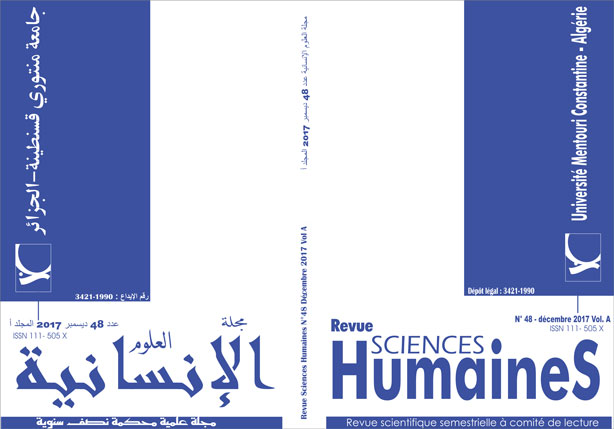Teaching English as a Foreign Language Using Multiple Intelligences, Cooperative Learning and Taking into Account the Pupils’ Perceptual Learning Styles
Keywords:
Multiple Intelligences, MI, Cooperative Learning, CL, Perceptual Learning StylesAbstract
This research aims at investigating whether the implementation of cooperative learning (CL) activities, involving the insights given by Howard Gardner’s theory of multiple intelligences (MI), and taking into account the pupils’ perceptual learning styles (PLS) in secondary school EFL classrooms, will have a positive effect on pupils’ English language proficiency and attitude. An experimental study was adapted. The place of this study was in two EFL classrooms (First year secondary school pupils, a class from the scientific stream and the other from the literary stream were taught for a whole year). Many learning activities adapted from the first year secondary school textbook “At the Crossroads”, and based on Gardner’s theory of Multiple Intelligences, were used while a Cooperative Learning approach was practiced, taking into account the pupils’ perceptual learning styles in designing the lesson plans. The data for the study was collected from two sources: The first one was the pupils’ questionnaire on attitudes and motivation, regarding CL, MI, and PLS. The second was from the pupils’ pretest and posttest scores on their language proficiency tests. The pupils’ first, mid and final-term examination marks were also taken into account. The results of the study showed that the experimental groups that were taught using the ideas based on CL, MI, including perceptual learning styles, outperformed the control groups based on Competency Based Approach( CBA) on the stimulated English proficiency tests for the three skills and the three achievement school examinations. Based on the results of our study, secondary school pupils can improve their achievements and their English language proficiencies through the implementation of new teaching methods based on cooperative learning, multiple intelligences theory and learners’ perceptual learning styles.
Downloads
References
Berman, M. (1998). “A Multiple Intelligences Road to an ELT Classroom.” Bencyfelin:Crown House Bruner, J. (1983). “Child’s Talk: Learning to Use Language.” Oxford: Oxford University Press
Casal Madinabeitia, S. (2002). “El Desarrollo de la Inteligencia Interpersonal Mediante las
Técnicas del Aprendizaje Cooperativo.” In M.C. Fonseca (Ed),
Inteligencias Múltiples, Múltiples Formas deEnseñar Inglés .
Sevilla: Mergablum
Chen, J-Q, and Gardner, H. (2005). “Assessment Based on Multiple Intelligences
Theory.” In D. P. Flanagan (Ed.), Contemporary
Intellectual Assessment: Theories, Tests, and Issues.
New York: Guilford Press, 77-102
Christison, M.A. (1996, Autumn). “Teaching and Learning Languages Through Multiple
Intelligences.” TESOL Journal,10-14
Christison, M.A. and Kennedy, D. (1999). “ Multiple Intelligences: Theory and Practice inAdult ESL.” University of Utah: Key resources
Crandall, J. (1999). “Cooperative Language Learning and Affective Factors.” In J. Arnold
(Ed.) Affect inLanguage Learning . Cambridge: Cambridge
University Press, 226-245
Felder, R. M., and Silverman, L. K. (1988). “Learning and Teaching Styles in Engineering
Education” [Electronic version]. Engineering Education, 78(7)
Gardner, H. (1983). “Frames of Mind. The Theory of Multiple Intelligences.”New York:Basic Books
Hall Haley, M. (2004). “Learner-Centered Instruction and the Theory of MultipleIntelligences with Second Language Learners.” Teachers
College Record. Vol. 106, No. 1, 163-180
Jensen, L. (2001). “Designing Lesson Plans” In. M .Celce-Murcia (Ed.) Teaching English
as a Second or Foreign Language . USA: Heinle &Heinlepublishers 403
Kinsella, K. (1995). “Understanding and Empowering Diverse Learners in ESL Classroom.”
In Reid (Ed.), Learning Styles in the ESL/EFL Classroom.
Boston: Heinle and Heinle Publishers
Lacey, A. and Walker, W.J. (1991). “Using Small Group Work to Motivate English
Students.” ERIC Document Reproduction Service. No, ED
224
Larsen-Freeman, D. (2007). “Techniques and Principles of Language Teaching.” (2nd Ed.).
Oxford: Oxford University Press
Lin, E. (2006). “Cooperative Learning in the Science Classroom.” Science Teach., 73(5): 35
Myers, I. B. and Myers P. B. (1995). “Gifts Differing: Understanding Personality Type.”Palo
Alto, CA: Davies-Black.
Oxford, R.L. (1995). “Gender Differences in Language Learning Styles: What do they
Mean?” In Reid (Ed.), Learning Styles in the ESL/EFL Classroom.
Boston: Heinle and Heinle Publishers
Reid, J. (Ed). (1995). “Learning Styles in the ESL/EFL Classroom.” Boston: Heinle and
Heinle Publishers, viii
Richards, J. & T. Rodgers. (2001). “Approaches and Methods in Language Teaching.”
Cambridge: Cambridge University Press
Sheridan Assessment College, (2008). “Sheriden English Proficiency Assessment”
http://assessment.sheridaninstitute.ca
Snider, D. P (2001). “Multiple Intelligences Theory and Foreign Teacher.” Unpublished
doctoral dissertation, University of Utah
















